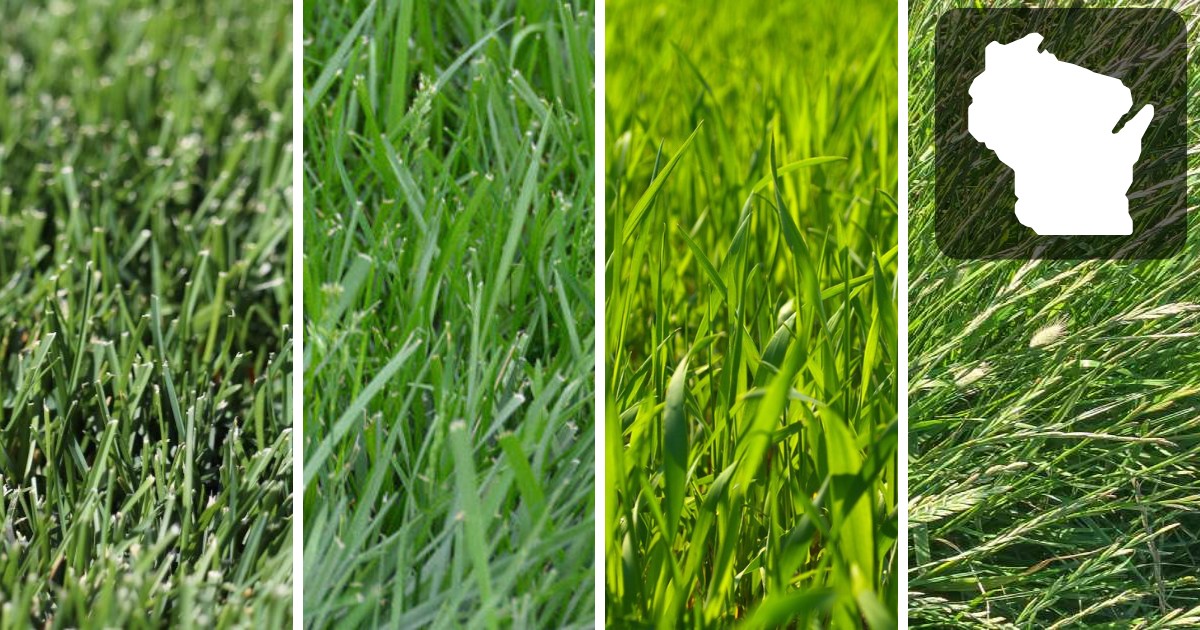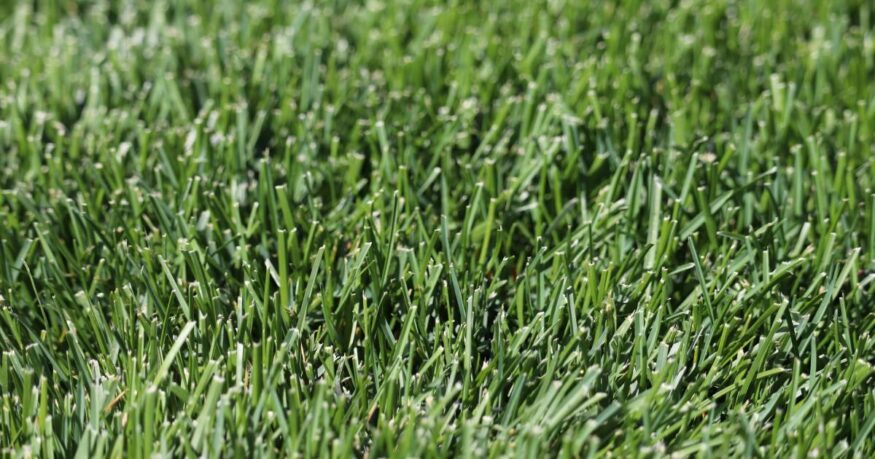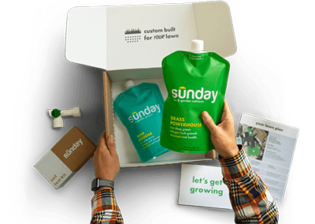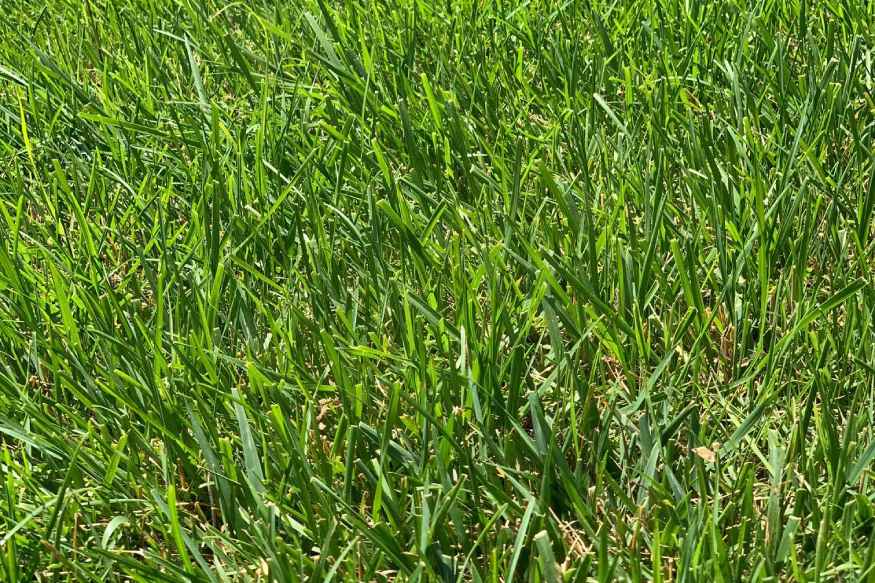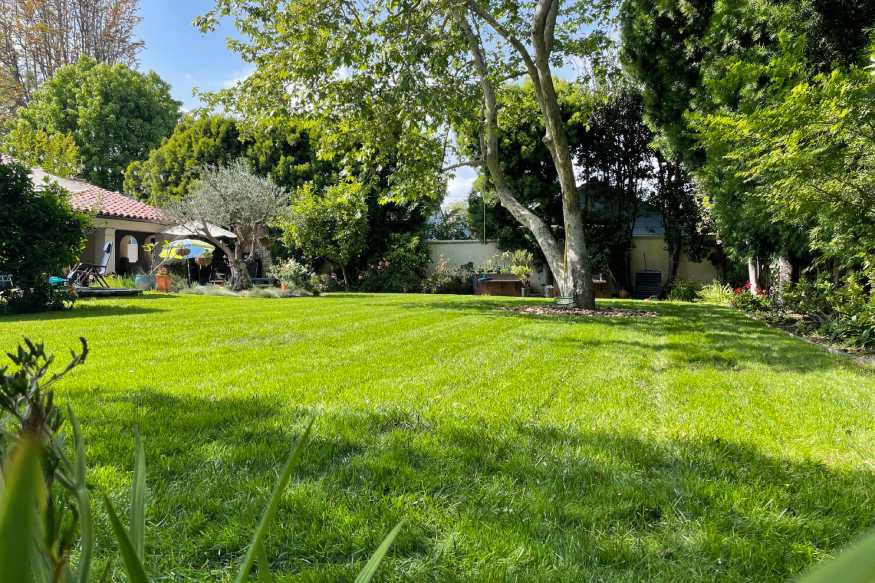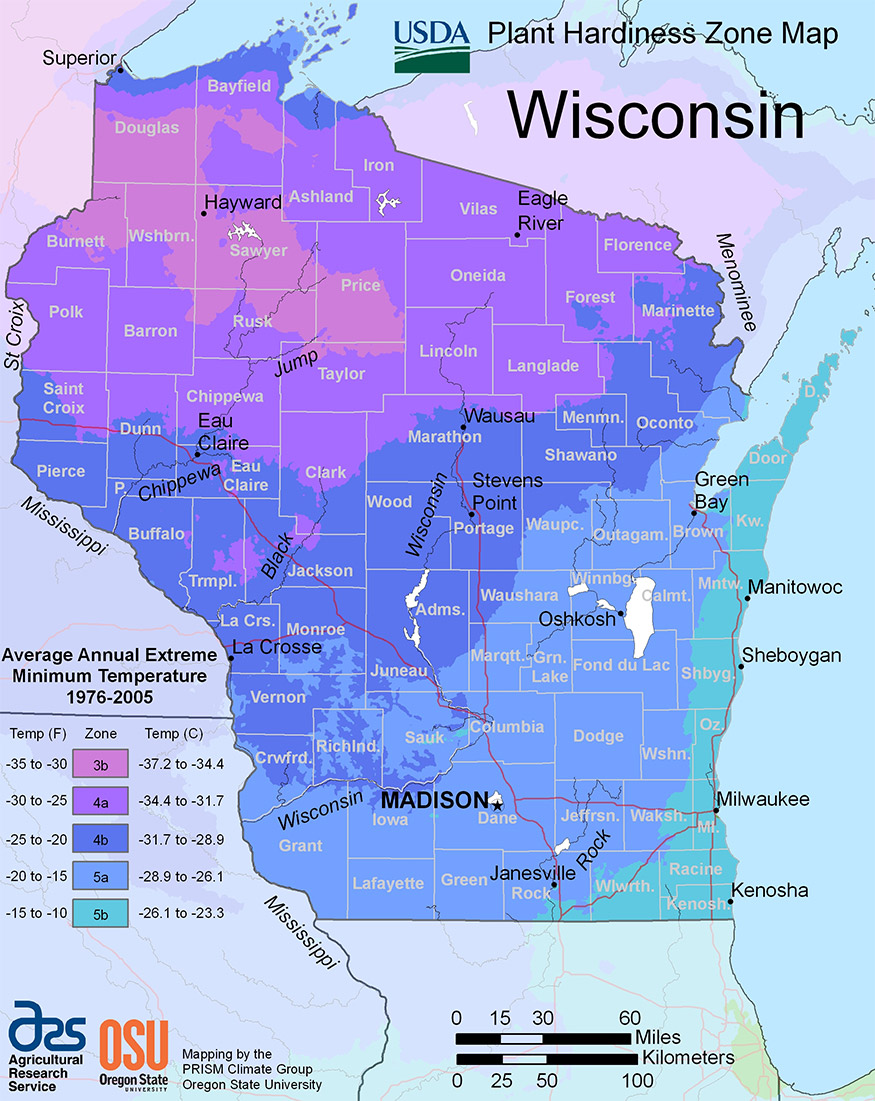Wisconsin, known for its rolling hills, scenic lakes, and harsh winters, can make it challenging for homeowners to maintain a lush, green lawn year-round.
The state’s climate is typically classified as continental, with hot summers and cold winters, which can make it difficult to find the right grass seed that will thrive in such extreme conditions.
While Kentucky Bluegrass is a reliable option, it’s not the only one, and other grass seed varieties may be better suited for different areas of the state.
In this article, we’ll explore the best grass seed options for Wisconsin and provide some tips for growing a healthy lawn despite the challenges.
[ez-toc]
Kentucky Bluegrass
| Also Known As | Poa pratensis L. |
| Type of Grass | Cool season perennial |
| Optimal Zones | Northern cool season zone, transition zones |
| Root Structure | Shallow |
| Winter hardiness | Excellent |
| Shade tolerance | Poor to Good |
| Water Requirements | High |
| Drought Tolerance | Poor |
| Self Repair Capacity | Excellent |
| Overall Maintenance Requirements | High |
Why Kentucky Bluegrass is The Most Popular Choice For Wisconsin
When it comes to choosing the perfect grass seed for your Wisconsin lawn, you can’t go wrong with Kentucky bluegrass. This resilient turfgrass is the most popular choice among cool-season grasses in the upper Midwest region for good reason.
With its dark green color, medium leaf texture, and aggressive spreading growth habit, Kentucky bluegrass is a top performer in most environmental conditions. Its deep root system allows it to thrive in colder climates, making it a great option for Wisconsin’s northern regions, where it can even withstand winter freezes.
One of the key advantages of Kentucky bluegrass is its high tolerance to drought and cold. Its deep root system allows it to withstand dry spells while still maintaining its lush appearance. The grass is also highly resilient and can withstand heavy foot traffic, making it ideal for lawns with active families or pets.
If you especially dislike patchy areas in your lawn, Kentucky bluegrass may be just the solution you need. This grass is known for its ability to spread itself out, filling in any gaps and creating a uniform lawn.
While Kentucky bluegrass can tolerate most environmental conditions, it does prefer at least six hours of sun per day to thrive. If your yard is heavily shaded, you may need to consider other options. However, for homeowners in cities like Milwaukee, Madison, and Green Bay, Kentucky bluegrass is an excellent choice for a hardy, freeze-resistant, and plush lawn.
When planting Kentucky bluegrass, it’s best to blend three or four different cultivars together to maximize the desirable traits of each and mask any undesirable ones. Early fall is the ideal time to lay the seed, allowing it to germinate and survive its first winter. Once established, this grass requires minimal maintenance, making it an easy choice for homeowners looking for a beautiful, low-maintenance lawn.
Looking for the best grass seed for your region?
Our smart lawn plans are designed to work perfectly with your local soil and climate conditions, without any of the toxic stuff.
Use the code EHG20 for an instant $20 discount!
- Personalized lawn care: Custom lawn plans based on soil analysis, climate data, and your specific lawn needs.
- Convenience with a conscience: Products that are not only easy to use but also safe for you, your pets, and the planet.
- Science-backed formulas: Bio-based formulas contain effective, natural ingredients like seaweed, molasses, and iron.
- Expert support: Get one-on-one guidance from a real person and rest easy with Sunday's satisfaction guarantee.
Tall Fescue
| Also Known As | Lolium arundinaceum (formerly Festuca arundinacea) |
| Type of Grass | Cool season perennial |
| Optimal Zones | Northern through transition zones |
| Root Structure | Deep |
| Winter hardiness | Excellent |
| Shade tolerance | High |
| Water Requirements | Medium to High |
| Drought Tolerance | Excellent |
| Self Repair Capacity | Limited |
| Overall Maintenance Requirements | Low |
What Makes Tall Fescue A Great Grass For Wisconsin
If you’re looking for a low-maintenance, durable grass option for your Wisconsin lawn, tall fescue is a solid choice. This grass has a narrow blade that grows upright and forms clumps of low-growing grass, making it an excellent option for utility areas or lawns with little foot traffic.
Unlike some grass types, tall fescue is resistant to salt damage and can tolerate both dry and moist soil conditions.
One of the key advantages of tall fescue is its resilience in extreme weather conditions. Its roots develop quickly and deeply, allowing it to withstand cold, heat, shade, and drought. This makes tall fescue a great option for homeowners in Wisconsin, where the weather can be unpredictable and harsh.
While tall fescue may not be as visually appealing as other grass types, its hardiness and low-maintenance requirements make it a practical choice for many homeowners. It prefers to grow in cooler temperatures and can be planted in either fall or spring.
One thing to keep in mind when planting tall fescue is that it tends to grow in bunches rather than spreading horizontally like some other grass varieties. To avoid uneven growth patterns, it’s important to spread the seed evenly and consider overseeding as needed.
Overall, tall fescue is an economical and resilient grass option that can thrive in a variety of conditions. Whether you’re planting in a shaded area or dealing with drought conditions, tall fescue is a great choice for a durable, low-maintenance lawn.
Perennial Ryegrass
| Also Known As | Lolium perenne L. |
| Type of Grass | Cool season perennial |
| Optimal Zones | Mild northern zones |
| Root Structure | Deep |
| Winter hardiness | Good to excellent |
| Shade tolerance | Moderate |
| Water Requirements | High |
| Drought Tolerance | Good |
| Self Repair Capacity | Excellent wear tolerance |
| Overall Maintenance Requirements | Moderate to high |
Why Perennial Ryegrass Grows well in MN
Perennial ryegrass is a versatile and dependable grass option for Wisconsin lawns. Although it does not have the ability to spread like Kentucky bluegrass, it more than makes up for it with its rapid establishment rate, good leaf color and texture, and high resistance to wear and tear. This makes it a popular choice to mix into your lawn, especially in shady corners where other seeds may struggle.
One of the key advantages of perennial ryegrass is its fast germination and rapid seedling growth, making it an ideal choice for overseeding in cooler temperatures. With the proper conditions, this grass can germinate faster than any other common lawn grass seed. Once established, it spreads slowly through vertical shoots known as tillers.
While traditional perennial ryegrass varieties have relatively shallow roots and limited heat and drought tolerance, improved varieties with greater heat and drought tolerance have been developed through research and breeding programs. Water-conserving blends with enhanced seed coat technology for quick establishment and lush, green, traffic-tolerant turf are also available, requiring up to 30% less water year after year.
Perennial ryegrass is a key component in cool-season grass seed mixes for northern and transition zone lawns and athletic fields. Its rapid establishment and wear resistance make it a popular choice for controlling erosion and providing quick stability, while slower germinating grasses such as Kentucky bluegrass get established. While it does prefer sun, it can tolerate lightly shaded conditions.
Overall, perennial ryegrass is a dependable and versatile grass option for Wisconsin lawns.
Wisonsin’s Climate And Growing Challenges For Lawns
Wisconsin is known for its varied climate, with hot summers and cold winters. This climate can pose challenges for growing and maintaining lawns in the area. Here are some of the main challenges to consider when choosing the best grass for your Wisconsin lawn.
Weather Challenges
Wisconsin experiences a wide range of weather conditions throughout the year. Summers can be hot and humid, while winters can be bitterly cold with heavy snowfall. This can make it difficult to find a grass type that can thrive in all conditions.
Soil Challenges
The soil in Wisconsin is typically heavy clay or loam, which can hold water for extended periods of time. This can make it challenging for grass roots to grow deep and establish a healthy lawn. Additionally, the soil may be acidic, requiring regular soil amendments to maintain a balanced pH level.
Pests and Disease Challenges
Wisconsin lawns are also vulnerable to pests and diseases, including grubs, chinch bugs, and fungal diseases. These can damage the grass and leave unsightly brown patches throughout the lawn.
Choosing the Right Grass
When choosing the best grass for your Wisconsin lawn, it’s important to consider the challenges of the local climate and soil conditions. Kentucky bluegrass is a popular choice for its hardiness and ability to withstand cold temperatures. Tall fescue is also a good option for its resilience to drought and wear and tear.
In conclusion, growing a healthy lawn in Wisconsin can be challenging due to the state’s variable climate, heavy soil, and pest and disease pressures.
However, by choosing the right grass type and taking the necessary steps to maintain healthy soil and prevent pest and disease damage, homeowners can achieve a beautiful and thriving lawn.
Looking for the best grass seed for your region?
Our smart lawn plans are designed to work perfectly with your local soil and climate conditions, without any of the toxic stuff.
Use the code EHG20 for an instant $20 discount!
- Personalized lawn care: Custom lawn plans based on soil analysis, climate data, and your specific lawn needs.
- Convenience with a conscience: Products that are not only easy to use but also safe for you, your pets, and the planet.
- Science-backed formulas: Bio-based formulas contain effective, natural ingredients like seaweed, molasses, and iron.
- Expert support: Get one-on-one guidance from a real person and rest easy with Sunday's satisfaction guarantee.
Frequently Asked Questions
What is the best grass seed for Wisconsin’s climate?
The best grass seed for Wisconsin’s climate depends on various factors such as soil type, sunlight exposure, and level of foot traffic. However, Kentucky Bluegrass and Tall Fescue are popular choices due to their resilience to the state’s extreme climate and ability to grow in different soil types.
Can I grow other grass varieties in Wisconsin besides Kentucky Bluegrass?
Yes, there are other grass seed varieties that can grow well in Wisconsin besides Kentucky Bluegrass. Perennial Ryegrass and Tall Fescue are suitable options for cooler climates and can tolerate shaded areas. It’s important to choose the right grass seed that’s best suited for your specific area’s soil type, climate, and level of sun exposure.
When is the best time to plant grass seed in Wisconsin?
The best time to plant grass seed in Wisconsin is during the early fall season, which is typically from late August to mid-September. This allows the grass to establish a root system before winter sets in. Spring is also a good time to plant grass seed, but it’s essential to avoid planting during the hot summer months, as the heat can damage the young seedlings.
How can I maintain a healthy lawn in Wisconsin?
To maintain a healthy lawn in Wisconsin, it’s important to fertilize regularly, mow at the correct height, and water appropriately. It’s also crucial to monitor your lawn for pests and diseases and treat them promptly. Additionally, soil testing can help determine if any soil amendments are necessary for optimal grass growth.
How often should I water my lawn in Wisconsin?
It’s recommended to water your lawn in Wisconsin once or twice a week for about an hour per session, depending on the weather conditions. It’s important to water deeply to encourage deep root growth and to avoid shallow roots that are more susceptible to drought. However, it’s essential to avoid overwatering, as it can lead to disease and insect problems.
